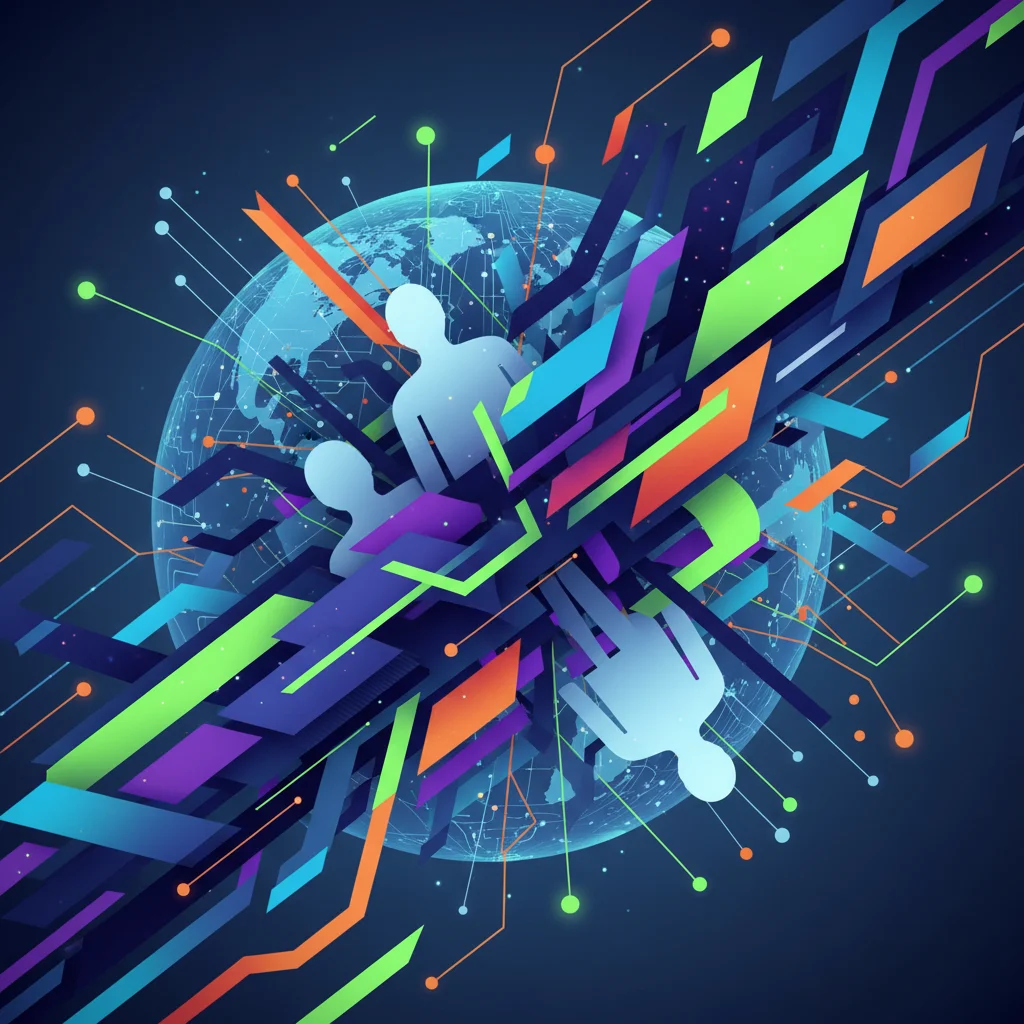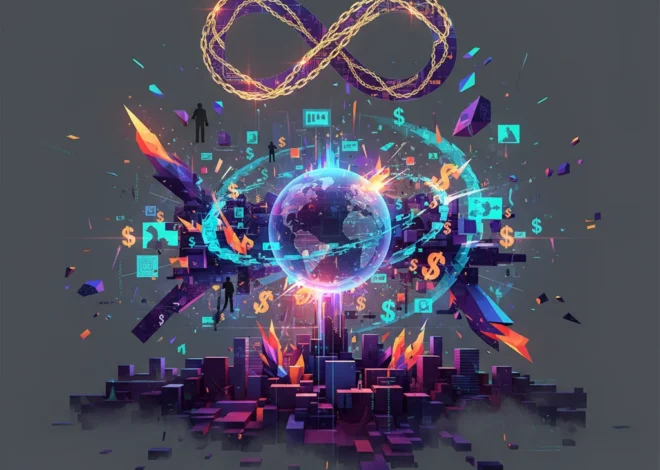
The Silent Takeover: How AI Bots Are Reshaping the Internet We Know
Are We Still the Majority Online? The Unseen Shift in Web Traffic
Take a moment to think about your last hour on the internet. You browsed some news, checked a social media feed, maybe looked up a fact on Wikipedia. It felt like a distinctly human activity, right? But what if I told you that for every click you made, another was made by a non-human entity? The digital world is undergoing a seismic, almost silent, transformation. We are rapidly approaching a tipping point where automated bots, not people, will represent the majority of internet traffic, a change that carries profound implications for everything from the software we build to the very nature of online knowledge.
This isn’t a far-off dystopian prediction; it’s the reality of today’s web infrastructure. At the heart of this revolution is a surge in sophisticated artificial intelligence and automation, and nowhere is this battle between human and machine activity more apparent than on the servers of the world’s largest online encyclopedia. The vast, user-generated knowledge base of Wikipedia has become a prime target, and a perfect case study, for understanding this new digital ecosystem.
In this deep dive, we’ll explore the forces driving this bot takeover, distinguish the helpful allies from the digital villains, and analyze the ripple effects for developers, entrepreneurs, and anyone who depends on a stable and authentic internet. The bots are here, and they’re changing everything.
The Tipping Point: A Web Woven with Automation
For years, bot traffic has been a significant but secondary part of the internet. That’s no longer the case. According to the 2024 Imperva Bad Bot Report, a staggering 49.6% of all internet traffic in 2023 was automated. This is the highest level ever recorded by Imperva and marks the fifth consecutive year of growth. For the first time, we are staring at a web where human activity is on the verge of becoming the minority.
This isn’t a sudden flood but the culmination of years of accelerating innovation in machine learning and cloud computing. As a recent BBC Tech Life report highlighted, the rise of generative AI has acted as a massive catalyst. These powerful AI models, from ChatGPT to Midjourney, are insatiably hungry for data to train on, and they deploy armies of bots to scrape the web for the text, images, and code they need. This has fundamentally altered the balance of traffic, pushing automated activity to unprecedented levels.
But not all bots are created equal. To truly understand the impact, we must separate the productive engines of the internet from the malicious saboteurs.
The Two Faces of Automation: Good Bots vs. Bad Bots
The word “bot” often conjures images of spam accounts and cyberattacks, but much of the automated traffic online is essential for the internet to function. The challenge lies in distinguishing these helpful scripts from their nefarious counterparts. Let’s break down the key players in this automated world.
| Category | Purpose & Function | Common Examples |
|---|---|---|
| Good Bots | Perform useful, often critical, automated tasks that support web infrastructure and services. They typically respect site rules (like robots.txt). | Search Engine Crawlers (Googlebot), SEO tools, website monitoring services, anti-vandalism bots on platforms like Wikipedia (e.g., ClueBot NG). |
| Bad Bots | Engage in malicious, deceptive, or resource-intensive activities that can harm websites, steal data, or disrupt services. They often ignore rules and disguise themselves as human traffic. | Web Scrapers (for data theft), Credential Stuffing Bots, Spambots, Ad Fraud Bots, and bots used in DDoS attacks. |
Good bots are the invisible workforce of the web. They index pages for search engines, monitor website uptime, and help maintain order. However, the rise in bad bot activity is a major driver of the traffic shift and poses a significant threat to cybersecurity. These bots are designed to exploit vulnerabilities, steal sensitive information, and commit fraud at a scale impossible for humans to replicate.
The AI in Your Kitchen: How Software and Automation Are Redefining Home Life
The Generative AI Gold Rush: Why Wikipedia is Ground Zero
So, why is Wikipedia at the epicenter of this trend? Because it’s a treasure trove of high-quality, structured, and fact-checked human knowledge—the perfect fuel for training Large Language Models (LLMs). The AI startups and tech giants driving the generative AI boom need this data to make their models smarter and more accurate.
Their method is simple: deploy sophisticated web-scraping bots to harvest decades of human collaboration from Wikipedia’s pages. This has several major consequences:
- Infrastructure Strain: The sheer volume of requests from these AI bots puts an enormous strain on the servers of platforms like the Wikimedia Foundation. It drives up costs for bandwidth and computing power, resources that are often supported by public donations.
- The Question of Value: This large-scale scraping raises critical ethical and economic questions. AI companies are building multi-billion dollar commercial products using data created and curated for free by a global community of volunteers. Is this fair use, or is it exploitation?
- The Blurring Lines: Advanced bots are becoming increasingly difficult to distinguish from human traffic, using techniques like IP rotation and mimicking human browsing patterns. This makes it harder for platforms to manage traffic and protect themselves from malicious activity.
This entire operation is powered by scalable cloud infrastructure, allowing a single developer or a small team to deploy a fleet of bots capable of scraping millions of pages in a short amount of time. It’s a new paradigm of data extraction, and the old rules of the web are struggling to keep up.
The Ripple Effect: What This Means for You
This shift from a human-centric to a bot-centric web isn’t just an abstract technical trend. It has tangible consequences for professionals across the tech industry and for society at large.
For Developers and Tech Professionals:
The rise of sophisticated bots presents a new set of challenges in programming and system architecture. Developers must now assume that a significant portion of their traffic is non-human and potentially malicious. This means implementing robust bot detection and mitigation strategies from day one. Techniques like advanced rate-limiting, fingerprinting clients, and employing intelligent CAPTCHAs are no longer optional. Building resilient, secure, and scalable applications requires a proactive defense against a web that is increasingly automated and adversarial.
JPMorgan’s New AI Co-worker Is Writing Your Performance Review
For Entrepreneurs and Startups:
For startups, this trend is both a threat and an opportunity. On one hand, skewed analytics from bot traffic can lead to poor business decisions, and scraping can mean your unique data or content is stolen by competitors. On the other hand, it opens up new markets for innovative solutions. There’s a growing demand for advanced SaaS platforms focused on bot management, API security, and data integrity verification. Entrepreneurs who can solve the problem of distinguishing valuable human engagement from costly bot noise will be well-positioned for success.
For the General Public:
Even if you’re not in the tech industry, you’re already feeling the effects. Ever wondered why you have to click on endless “I’m not a robot” puzzles? That’s a direct consequence of the bot problem. Slower website loading times, the spread of misinformation by automated accounts, and the risk of your personal data being stolen through credential-stuffing attacks are all part of this new reality.
The Path Forward: Coexistence or Conflict?
So what’s the solution? The old gentlemen’s agreement of the web, the `robots.txt` file, is proving insufficient. It’s a request, not a command, and bad bots simply ignore it. The path forward will likely involve a multi-pronged approach combining technical innovation, new business models, and evolving web standards.
We are already seeing platforms fight back. Reddit, another major source of training data, began charging for API access, effectively putting a price on its data to deter mass scraping. This signals a move towards a more transactional web, where high-volume data access is no longer a free-for-all. This could level the playing field, but also risks creating a more closed and commercialized internet.
In the long run, the solution may lie in creating a web that is more explicitly designed for both humans and machines. This could involve cryptographic signatures to verify content origin, new protocols for AI agents to declare their intent and usage rights, and a greater emphasis on authenticated digital identity. The goal isn’t to eliminate bots—they are too integral to the web’s function—but to create a system of accountability and transparency.
Conclusion: Redefining Our Digital World
The internet is no longer just a network for people. It is a bustling ecosystem of human and artificial actors, and the balance of power is shifting beneath our feet. The rise of bot traffic, supercharged by the AI revolution, is a testament to incredible technological innovation, but it also presents one of the most significant challenges to the open web we’ve ever faced. It forces us to confront fundamental questions about data ownership, cybersecurity, and the very authenticity of our digital information.
This silent takeover isn’t an endpoint; it’s the beginning of a new chapter. As we architect the next generation of software and build the businesses of tomorrow, our success will depend on our ability to navigate this complex new landscape. The challenge is to harness the power of automation while preserving the integrity and human-centric spirit that made the internet a revolutionary force in the first place.


